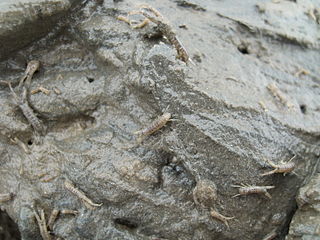
Amphipoda is an order of malacostracan crustaceans with no carapace and generally with laterally compressed bodies. Amphipods range in size from 1 to 340 millimetres and are mostly detritivores or scavengers. There are more than 9,900 amphipod species so far described. They are mostly marine animals, but are found in almost all aquatic environments. Some 1,900 species live in fresh water, and the order also includes the terrestrial sandhoppers such as Talitrus saltator and Arcitalitrus sylvaticus.

Gammaridea is one of the suborders of the order Amphipoda, comprising small, shrimp-like crustaceans. Until recently, in a traditional classification, it encompassed about 7,275 (92%) of the 7,900 species of amphipods described by then, in approximately 1,000 genera, divided among around 125 families. That concept of Gammaridea included almost all freshwater amphipods, while most of the members still were marine.

Corophiidae is a family of amphipods, containing the following genera:
Paracorophium excavatum is a species of amphipod in the family Corophiidae. It has been confused with other species, such that the only reliable record is from its type locality at Brighton, Otago.
Allorchestes compressa is a species of amphipod in the family Dogielinotidae. It is found around the coast of Australia from Western Australia to Tasmania and east to Illawarra, New South Wales.
Chiltonia is a genus of amphipod crustaceans endemic to New Zealand. Four species are known, three of which live in fresh waters. They were first discovered by Charles Chilton in 1898 and the genus Chiltonia was erected the following year by T. R. R. Stebbing in Chilton's honour.
Paracorophium is a genus of amphipods in the family Corophiidae.
Paracalliope is a genus of amphipod crustaceans that live in Australasia. They include the most common freshwater amphipods in New Zealand, where they are particularly frequent in slow-flowing reaches of rivers. They shelter among weed beds and are important prey items for fish such as the New Zealand smelt, Retropinna retropinna, which are in turn important prey for the freshwater eels Anguilla australis and Anguilla dieffenbachii. Paracalliope acts as an intermediate host for the nematode Hedruris spinigera, which can thus reach their primary host, the eel.
Paracrangonyx is a genus of amphipods in the family Paracrangonyctidae, comprising two species, Paracrangonyx compactus and Paracrangonyz winterbourni.
Phreatogammarus is a genus of amphipod crustaceans that are endemic to New Zealand. It is the only genus in the family Phreatogammaridae, and contains four species, three of which were described by Charles Chilton.

Gammaridae is a family of amphipods. In North America they are included among the folk taxonomic category of "scuds", and otherwise gammarids is usually used as a common name.

Isoplectron is a genus of cave wētā in the family Rhaphidophoridae with three species currently recognised. The genus is endemic to New Zealand and distributed throughout the country.

Gammarus is an amphipod crustacean genus in the family Gammaridae. It contains more than 200 described species, making it one of the most species-rich genera of crustaceans. Different species have different optimal conditions, particularly in terms of salinity, and different tolerances; Gammarus pulex, for instance, is a purely freshwater species, while Gammarus locusta is estuarine, only living where the salinity is greater than 25‰.

Calliotropis crystalophora is a species of sea snail, a marine gastropod mollusk in the family Eucyclidae.

Corophiidira is a parvorder of marine amphipod crustaceans in the infraorder Corophiida. In a previous classification, this taxon was treated as an infraorder and was then itself called Corophiida.
Paramoera walkeri is an amphipod of the genus Paramoera. It lives around Antarctica.

Bathyporeiidae is a family of amphipods in the order Amphipoda. There are two genera in Bathyporeiidae:
Pseudamphithoides incurvaria is a species of amphipod crustacean in the family Ampithoidae. It is native to shallow water in the tropical western Atlantic Ocean where it creates a home for itself from fragments of the algae on which it feeds. This seaweed contains certain chemicals that are distasteful and protect it from predatory fish.
Iphigenellidae is a freshwater family of amphipods in the superfamily Gammaroidea. It is found in the Ponto-Caspian region, which encompasses the Black, Azov, and Caspian Seas.

Stenoperla prasina is a species of stonefly belonging to the family Eustheniidae. This species is endemic to New Zealand and is classified as "Not Threatened" under the New Zealand Threat Classification System. It is found on the North, South and Stewart Island / Rakiura Islands as well as on Little Barrier Island. Although adults of this species are most often coloured bright green, this species can be coloured yellow. This species inhabits clean, cold, running streams and rivers with stony bottoms within native bush. It is a known indicator of water quality. The larvae eat plant detritus and other aquatic insects while the adult insects feed on sooty mould fungi as well as other plant matter. The adults of this species are a known food source for New Zealand long tailed bats. Adults have been dissected and have been found to have been carrying Nematomorpha and trematode parasites. The New Zealand Department of Conservation classifies this species as "Not Threatened". In 2022 a specimen of this species was the 5 millionth specimen to be digitised in the Natural History Museum, London collection.







